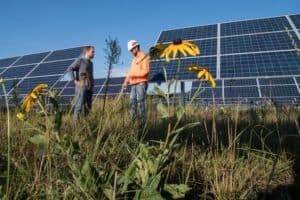
NREL scientist Jordan Macknick and Jake Janski, from Minnesota Native Landscapes survey a pollinator test plot planted underneath the photovoltaic array at the Chisago Solar Site, part of the Aurora Solar Project in Minnesota. Credit: Dennis Schroeder National Renewable Energy Lab
Credit: Flickr
The tidy rows of gleaming solar panels at Pine Gate Renewables facility in southwestern Oregon originally sat amid the squat grasses of a former cattle pasture. But in 2017 the company started sowing the 41-acre site with a colorful riot of native wildflowers. The shift was not merely aesthetic; similar projects at a growing number of solar farms around the country aim to help reverse the worrying declines in bees, butterflies and other key pollinating species observed in recent years.
Up to $577 billion in annual global food production relies on pollination by insects and other animals such as hummingbirds and bats, according to the United Nations. But more than half of native bee species (pdf) in the U.S. have seen their numbers drop sharply since 2005, with almost […]










